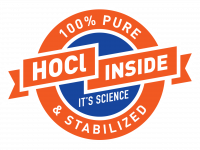HOCl-Based Hand Sanitizers (Part 1)
Story At-A-Glance
- Alcohol-based hand sanitizers have become the default standard.
- The use of alcohol-based hand sanitizers can cause skin reactions and allergies.
- Research indicates HOCl products have the potential to be as good as – or better than – alcohol-based hand sanitizers in sanitizing human skin and hands.
- All HOCl products are not equal. The specific attributes of a particular HOCl product affects its ability to kill germs.
Skin & Hand Disinfection
Ensuring proper cleansing of hands is known to be an important way to control the spread of harmful germs between humans. With the announcement of a global pandemic in March 2020, hand sanitizing became one of several preventative measures adopted to slow the spread of the virus. The U.S. Centres for Disease Control and Prevention was one global health agency which encouraged the use of hand sanitizing throughout the pandemic.1
Hand sanitizers can generally be categorized as either alcohol-based or alcohol-free.2 Alcohol-based hand sanitizers include ethanol, isopropanol, n-propanol, and hydrogen peroxide and normally include 60 to 95% alcohol concentration of total volume of the product (v/v).3 The World Health Organization, a global health agency, recommends alcohol-based hand cleansers (ABHS) as they are very fast acting and kill a broad range of germs.4 Alcohol-based hand sanitizers have traditionally been used in many settings because of their simplicity encourage their adoption.5
The Negative Side Effects of Alcohol-Based Sanitizers
The use of alcohol-based hand sanitizers can cause skin reactions and allergies for some people which can manifest in dryness, itchiness, erythema (a redness, infection, or inflammation of the skin), and bleeding in severe situations.6 Repeated use of ABHS can cause the drying of skin on the hands, which can lead to peeling or cracking.7 Among the ABHS varieties, the most irritating to the skin are n-propanol and isopropanol.8
Pure HOCl as a Hand Sanitizer
HOCl is the primary killing agent in electrolyzed water (EW). For more detail on EW, see here and here. EW has been used for many years as a disinfectant and cleaner, and it has a broad range of applications. EW is made from salt and water in an electrolysis chamber.9 The terms HOCl and EW are often used interchangeably. EW and HOCl are considered completely safe for human use on the hands, skin, and mucous membranes.10
An in-vitro study was performed which compared HOCl 0.01% against isopropyl alcohol 70% in killing common germs found on the skin.11 For all germ types measured, HOCl’s ability to kill was immediate, whereas isopropyl alcohol, for some germ types, took as long as 1 minute to take effect.12 In this study, HOCl 0.01% was found to be as effective – or more effective – than isopropyl alcohol in killing the germs.13 Another study compared HOCl 0.01% against isopropyl alcohol 70% in its ability to kill germs on human facial skin.14 This study found no significant difference between HOCl 0.01% and isopropyl alcohol 70% in its ability to kills germs found on the face.15
Factors Affecting HOCl Efficacy
All HOCl products are not equal. The ability of HOCl to kill germs on human skin is highly dependent on its pH and the stability of its formulation.16 Stability refers to how long the HOCl formulation maintains the same level of ability to kill germs. Stability is normally optimized between a pH range of 3.5 to 5.5.17 A study compared the germ-killing efficacy of a stable HOCl formulation against a non-stable HOCl combined with an acidified bleach.18 The stable HOCl outperformed the non-stable/acidified bleach formula.19
Attaining a consistent pH and stability of HOCl formulation is highly dependent on strict adherence to process and the quality of the components used in the formula. The concentration of electrolyte, water flow rate, and water source (hardness) all affect the chemistry of the EW20. For HOCl products, the inputs and input processes are very critical to their efficacy. To ensure the most efficacious HOCl product, it is best to select an HOCl product which is stable and has a neutral pH. The process in generating the HOCl must use an optimum amount of salt concentration from one mix to the next, the correct type of water hardness, and consistent water flow rate in its manufacturing process.21 Consistency in process makes all the difference!
Research indicates HOCl-based hand sanitizers have the potential to be as good or better than alcohol-based hand sanitizers in sanitizing human skin and hands. Selecting the right HOCl product will make the transition from alcohol-based hand sanitizers to an HOCl-based hand sanitizer even easier!
Sources and References
- 1-8 Hand Sanitizers: A Review on Formulation Aspects, Adverse Effects, and Regulations, International Journal of Environmental Research and Public Health, 11 May 2020, Jane Lee Jia Jing, Thong Pei Yi, Rajendran J. C. Bose, Jason R. McCarthy, Nagendran Tharmalingam, and Thiagarajan Madheswaran
- 9,10 New Clinical Applications of Electrolyzed Water: A Review, Microorganisms, 8 January 2021, Pianpian Yan, Eric Banan-Mwine Daliri, and Deog-Hwan Oh
- 11-13 0.01% Hypochlorous Acid as an Alternative Skin Antiseptic: An In Vitro Comparison, National Library of Medicine, PubMed.gov, 2018 December, Apostolos G Anagnostopoulos, Andrew Rong, Darlene Miller, Ann Q Tran, Trajen Head, Michael C Lee, Wendy W Lee
- 14-15 Comparison of Skin Antiseptic Agents and the Role of 0.01% Hypochlorous Acid, July 17, 2020, Cosmetic Medicine, Ann Q. Tran, MD; Nicole Topilow, MD; Andrew Rong, MD; Patrice J. Persad, PhD; Michael C. Lee; James H. Lee; Apostolos G. Anagnostopoulos, MD; and Wendy W. Lee, MD, MS
- 16-21 Status Report on Topical Hypochlorous Acid: Clinical Relevance of Specific Formulations, Potential Modes of Action, and Study Outcomes, 2018 November, James Q Del Rosso, Neal Bhatia
